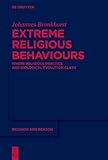Extreme Religious Behaviours : Where Religious Practice and Biological Evolution Clash / Johannes Bronkhorst.
Material type: TextSeries: Religion and Reason : Theory in the Study of Religion ; 70Publisher: Berlin ; Boston : De Gruyter, [2024]Copyright date: 2024Description: 1 online resource (VIII, 207 p.)Content type:
TextSeries: Religion and Reason : Theory in the Study of Religion ; 70Publisher: Berlin ; Boston : De Gruyter, [2024]Copyright date: 2024Description: 1 online resource (VIII, 207 p.)Content type: - 9783111374215
- 9783111374468
- 9783111374406
- 200.1
- online - DeGruyter
- Issued also in print.
| Item type | Current library | Call number | URL | Status | Notes | Barcode | |
|---|---|---|---|---|---|---|---|
 eBook
eBook
|
Biblioteca "Angelicum" Pont. Univ. S.Tommaso d'Aquino Nuvola online | online - DeGruyter (Browse shelf(Opens below)) | Online access | Not for loan (Accesso limitato) | Accesso per gli utenti autorizzati / Access for authorized users | (dgr)9783111374406 |
Frontmatter -- Preface -- Contents -- Introduction -- Part I: Theory -- Chapter 1: The role of absorption in various religious phenomena -- Chapter 2: Language and the mind -- Chapter 3: Mystical experience -- Chapter 4: Religion as memory -- Chapter 5: Psychological trauma and mystical experience -- Part II: Extreme behaviours -- Introduction -- Chapter 6: Rites related to hierarchy -- Chapter 7: Asceticism -- Chapter 8: The Buddhist noble truths: Are they true? -- General conclusions -- Bibliography -- Abbreviations -- Index
restricted access online access with authorization star
http://purl.org/coar/access_right/c_16ec
Certain religious behaviours clearly reduce biological fitness. These behaviours include celibacy along with various forms of asceticism, and rituals that harm the performer. Such behaviours are found in widely different cultures. How is this possible? This book shows that these behaviours (as is religion in general) are by-products of features of the human mind whose evolutionary fitness is beyond doubt and explores those features. Which are those features? This book proposes a twofold answer. It draws attention to the layered nature of human consciousness, in which different manners of experience are superimposed on each other. This goes a long way toward accounting for the universal religious belief in some kind of transcendental world, a "higher" reality, different from "ordinary" reality. The layering of consciousness comes about in childhood and gains in prominence with the acquisition of a first language, which is the second feature highlighted in this book. Together, these features explain a variety of "normal" religious behaviours and beliefs, and account for the possibility of mystical experience. They also explain the occurrence of behaviours that do not augment evolutionary fitness.
Issued also in print.
Mode of access: Internet via World Wide Web.
In English.
Description based on online resource; title from PDF title page (publisher's Web site, viewed 20. Nov 2024)


